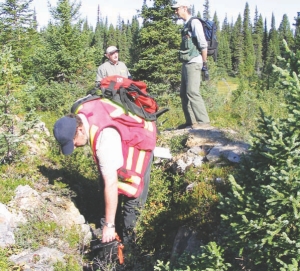VANCOUVER — A 20% increase in resources is a nice boost for a company only working through pre-feasibility studies. And that’s exactly what Aurora Energy Resources (AXU-T) got: the company’s Michelin uranium deposit, which is the centerpiece of its large Central Mineral Belt project in Labrador, has grown in size and grade.
Michelin hosts both a deep deposit and an open pit target.
In the deeper deposit, measured resources sit at 1.29 million tonnes grading 0.12% U3O8, an 11% grade increase over the previous estimate. Indicated resources contribute 16.2 million tonnes grading 0.13% U3O8 and inferred resources finish the deep tally with 12.6 million tonnes grading 0.12% U3O8.
The open-pit target hosts 5.8 million tonnes grading 0.08% U3O8 in the measured category, 7.15 million indicated tonnes grading 0.06% U3O8, and 1.56 million inferred tonnes grading 0.05% U3O8.
Combined, Michelin’s measured and indicated resources contain 67.4 million lbs. U3O8 while inferred resources add another 35.5 million lbs. U3O8.
The project is still open for expansion, and Aurora is in the midst of a 20,000-metre, seven-rig winter program focused on infill and geotechnical drilling.
In March, Aurora expects to update resource estimates for Jacques Lake, 30 km to the northeast of Michelin, and for the Rainbow, Gear, Inda Lake, and Nash targets along the project trend.
The mineralized material at Michelin appears to be conventional and uncomplicated with respect to processing. Tests have shown that standard crushing and grinding combined with traditional leach processing gives acceptable levels of mineral extraction. In addition, the mineralized material and surrounding rocks contain very low levels of deleterious metals, as well as low levels of sulphide and high levels of carbonate, indicating acid rock drainage is not a significant concern for waste rock or tailings.
Aurora expects to submit its project description, including Michelin and Jacques Lake, to federal and provincial authorities in the coming second quarter, which would initiate the project’s environmental assessment process.
Aurora moved up 5 on the resource boost news to close at $8.90. The company has a 52-week trading range of $7.75 to $20.09 and has 73 million shares issued. Fronteer Development Group (FRG-T, FRG-X), which owns slightly less than half of Aurora, moved up 39 to close at $8.99. Fronteer has a 52- week range of $7.50 to $17.59 and has 83 million shares issued.
JUTLAND INSULATED PORTABUILDINGS
FOR A HEALTHY ENVIRONMENT THAT’S WARM, DRY & FUEL EFFICIENT


Be the first to comment on "Aurora’s Michelin grows (March 03, 2008)"